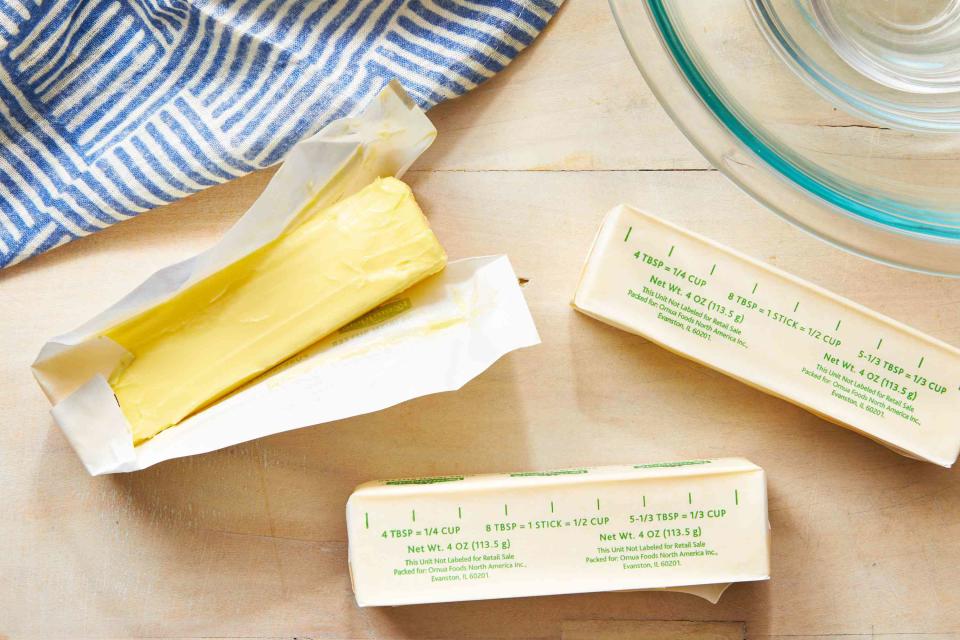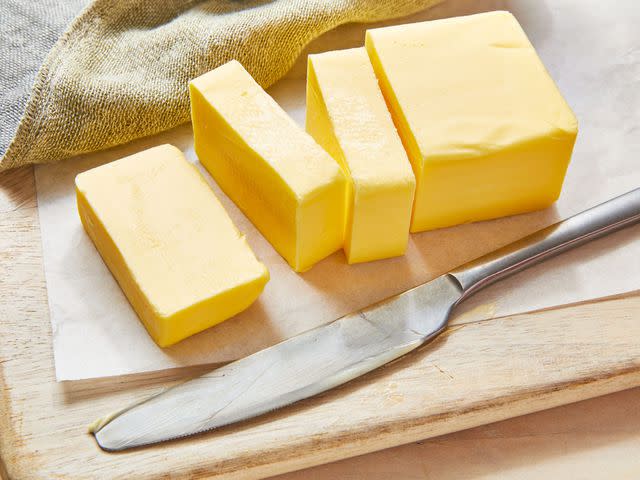11 Types of Butter—And How To Use Them
Confused about butter choices at the grocery store? Here’s what you need to know.

Caitlin Bensel; Food Styling: Torie Cox
Nothing makes a meal more comforting than a warm buttermilk biscuit cut open to make room for a pat of creamy butter. The dairy product is not only the finishing touch on all breads, but is a prominent ingredient in everything from frosting to sauces in Southern cooking.
However, there are so many butter sticks, tubs, and bars that the dairy section can be quite confusing. Here are the types of butter that are typically found on the shelves and why they might be the right choice.
The Most Common Types of Butter—And How to Use Them
Before you pick up another stick or tub, red about these butters and decide which is the right one for your recipe.
Salted
A great addition to that biscuit mentioned, salted butter brings out the flavor of food. Salt is a preservative, extending the life of the butter past the unsalted version. Typically, recipes use this as an enhancement. It’s the go-to for the butter dish on the table or finishing off vegetables, as unsalted butter is fat but not flavor. Use this method to soften the stick, making it easily spreadable.
:
Unsalted
Butter without salt is the usual choice for baking. While a few recipes call for salted butter, most are created to use unsalted.
There’s a reason for this. Salted butters have different amounts of salt in each brand. If you want a controlled amount of salt in your recipe, use unsalted butter and add the salt separately.
:
Whipped
Whipped butter is just that, butter that’s been whipped with some added milk, cream, or water to give it a soft, spreadable feel. This is a great choice for the table to spread on pancakes at breakfast or rolls at dinner.
Extra Creamy
Butter is usually around 80% butterfat. Extra creamy butter has more, giving it a richer taste and smoother texture.
Grass-Fed
Since butter is made from churning cows milk, it does make a difference what the particular cow eats all day. Having butter made from the milk of cows eating a natural diet of fresh grass results in a butter higher in certain nutrients.
But grass-fed butter is more expensive. Eight ounces runs around $4.50, while a pound of regular butter is almost the same price for twice the amount.
Organic
Organic butter is made from cream or milk that came from cows living under specific guidelines set by the Food and Drug Administration (FDA). To be called organic, the milk can’t come from cows that are exposed to hormones, pesticides, or antibiotics in the food they eat, and they must be fed at least 60% of their diet from organic grass. This is about as pure as it can get.

Irish
You’ll notice that Irish butter is a little more orange than regular butter. That’s because the cows, fed on the grass fields of Ireland, are exposed to a different diet than conventional livestock. It’s also a little creamier, due to the 82% buttterfat that’s commonly found in European butter.
Irish butter is a fantastic choice for baking because of that higher fat content, creating tender and flaky desserts and pastries.
:
Cultured
This butter is made the same way that regular butter is, but with one big difference: After the butter is pasteurized, live cultures are added, and the mix is allowed to ferment. The resulting taste is more like buttermilk, a tangy treat. Try cultured butter in these compound butter recipes for full flavor.
European
While American butters are required to have 80% butterfat, European butters hover between 82% and 90%. The process for churning lasts longer to create that signature creaminess, and the butter is a little brighter in color because of the typical fresh grass diet of the cows. While both butters function around the same in recipes, European butter is perfect to finish off dishes.
Ghee
Ghee is a type of butter that’s clarified, meaning that all the milk solids and water have been removed to leave just the butterfat. If you’re comparing, ghee has 99% to 100% butterfat. It’s cooked a little longer than clarified butter normally is, resulting in a nutty taste like browned butter.
This type of spread is able to be stored on the shelf with a long life, and it's great for people who are lactose intolerant. While ghee is a perfect choice to sauté vegetables, it won’t work for baking.
Margarine
While this is certainly not real butter, margarine has been used for years as a substitute for its convenience and lower price point. It’s easy to spread right out of the refrigerator and can stay on the counter without melting, but there are concerns about the ingredients of oil, water, salt, and emulsifier.
Some margarines were previously made with trans-fat filled oils, though that’s changed in the last few years. While the FDA banned trans-fats in foods in 2018, some methods that make margarine might still produce trace amounts. It’s such a low percentage though, the nutrition labels still reflect zero trans-fats. The Mayo Clinic even recommends margarine as a good choice for heart health.
:
Bottom Line
With so many types of butter to choose from in grocery stores, consumers can feel confident that they can find a choice that fits their dietary needs. Make sure to read the labels and make the choices that fit your budget, the dish, and your diet.
For more Southern Living news, make sure to sign up for our newsletter!
Read the original article on Southern Living.

